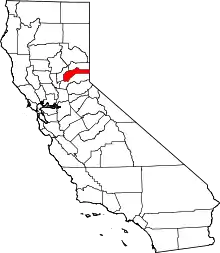Baltimore Town, California
Baltimore, previously Wightman’s Camp, was a historic mining camp in eastern Nevada County which existed for a few years after 1865. It was situated in the High Sierra at an elevation of 7,477 ft (2,279 m) above sea level, about 4 miles north of Cisco Grove, and about 10 linear miles west of modern Highway 89. Its history is intertwined with that of the Excelsior mining district whose principal town was Summit City (later called Meadow Lake) located on Meadow Lake.[2]
Baltimore | |
|---|---|
Former settlement | |
 Baltimore Location in California | |
| Coordinates: 39°23′12″N 120°31′51″W | |
| Country | |
| State | |
| County | Nevada County |
| Elevation | 7,477 ft (2,279 m) |
The creation of the Excelsior mining district is attributed to Henry Hartley, a trapper who built a cabin near Meadow Lake around 1860.[3] In June 1863, he discovered gold and staked out several claims. Others followed and by the spring of 1865, rumors of gold in the area created a local gold rush. Not only was gold reported to be plentiful, unlike many mining districts, year-round water was readily and abundantly available. By the summer of 1865, hundreds of miners, many from the Virginia City area, had flocked to the remote area, even though, as one historian observed, “[g]etting to the Meadow Lake country was no easy matter.“[4]
By late June, the 160 acre town of Summit City was laid out by Virginia City promoters A.C. “Alex” Wightman and Charley Parker. Later that year, Wightman laid out three satellite towns, including one about 2 miles southeast of Summit City on the northwest side of Old Man Mountain near Wagon Wheel Lake.[5] The town was connected by a toll road to Summit City.[6] Initially called Wightman’s Camp, it soon became Baltimore since Wightman was a native of Baltimore, Maryland.[7] Sometimes, the word Town or City appears after the word Baltimore to distinguish it from the one in Maryland.[8]
Prospects for Baltimore initially appeared promising. It was located near the promising Baltimore ledge of gold-bearing granite. The principal mines included the Keystone and the Potosi, both owned by Hartley, the Sacramento and the Justice.[9] In November 1865, it was described as "a flourishing place, and in the spring many buildings for business purposes will be erected."[10] However, the gold rush to the Excelsior district proved to be a bubble, which quickly burst. Though gold was there, it proved to be very difficult and expensive to extract from the other minerals to which it was bound.[11] By 1869, the population of Meadow Lake had dropped from 4000 to 60.[12] It along with Baltimore and the other towns in the area were soon abandoned. In 1880, Baltimore was described as a town “which once had five or six buildings, but whose site is now marked by one lonely and deserted house.”[13]
References
- U.S. Geological Survey Geographic Names Information System: Baltimore Town, California
- Fatout, Paul (1969) Meadow Lake Gold Town, pp. 32-40.
- Id. p. 29.
- Id. p. 37.
- Id, map p. 2.
- Id, p. 40.
- Morning Union, June 22, 1875.
- Fatout, Ibid, p. 37.
- Thompson, Thomas H. and West, Albert A. (1970 ed.) History of Nevada County -1880, p. 196.
- Marysville Daily Appeal, Nov. 10, 1865.
- Fatout, Ibid, p. 103.
- Comstock, David and Zimmerman, Bernard (2018 electronic edition, You Bet Press) Exploring Nevada County: Historical Landmarks, Site 143.
- Thompson and West, Ibid, p. 196.
